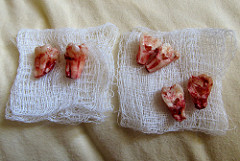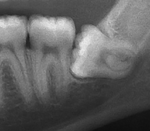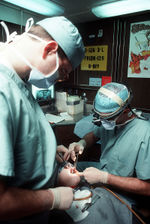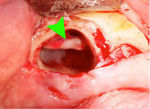Wisdom tooth extraction
Wisdom tooth extraction is a fairly common surgical procedure performed on the third molars. Often, there is insufficient space in the mouth to accommodate these teeth, causing them to grow in partially, and causing damage to other teeth. Among other complications, they can also cause discomfort. Luckily, this procedure is fairly straight forward and can be done by a maxillofacial surgeon. Removing these teeth also removes the risk of developing gum disease and other adverse affects caused by these teeth being a hard to reach and hard to clean obstruction in the mouth. The surgery does have a few risks, however; they are usually avoidable if the patient follows the surgeons advice following the surgery.
Problems Causing Surgery
Wisdom teeth are usually the last adult teeth to come in, or erupt, around the ages of 17-21. These teeth are called third molars by dentists and often become impacted because there is not enough room for them in the mouth. Most people have four of these teeth, two on top and two on bottom. Sometimes, these impacted teeth are hard to notice and do not cause any immediate problems. However, they are hard to clean and are therefore more susceptible to tooth decay and gum disease. Impacted teeth can become infected causing symptoms such as red and swollen gums, bleeding gums, bad breath, jaw pain, swelling around the jaw, difficulty opening the mouth and an unpleasant taste in the mouth. The third molars do not always cause problems. In some people, the teeth come in and line up correctly behind the second molars without any complications. However if the mouth is too crowded for the teeth to emerge and develop properly (as is most often the case), they become trapped, or impacted. A wisdom tooth can be partially impacted where it breaks through the gum slightly so the crown is visible or it can be fully impacted where it never breaks through the gum. The impacted tooth can do many things such as: grow at an angle toward the second molar, grow at an angle toward the back of the mouth, grow at a right angle giving the impression that it is "laying down" along the jawbone, and lastly it can grow straight up, but stay trapped in the jawbone.
Certain complications can arise from an impacted tooth. If the third molar is pushing against the second molar, the pressure can crowd the teeth and push them together. It can also damage the second molar and increase the chance for an infection. The wisdom tooth forms in a sac in the jawbone. Sometimes this sac will fill with fluid which forms a cyst. This cyst can damage the teeth, jawbone and nerves. It can also cause a benign tumor to develop, although this is quite rare, and this requires removal of tissue and bone. Partially impacted teeth are hard to reach and clean and food and bacteria easily becomes trapped around the tooth making it prone to decay. As a result of this, a person could develop a painful inflammatory gum disease called pericoronitis.[1]
Procedure
The procedure is performed by an oral or maxillofacial surgeon in the dentist's or surgeon's office although the surgery could be done in a hospital especially if all the wisdom teeth are being extracted at one time or if the individual is at a higher risk for complications. If the person has any infections, the surgery will be delayed until the infection is cleared up or the patient will take antibiotics as a precaution. The two ways to prevent pain during the surgery are through local anesthesia or general anesthesia.[2] Local anesthesia is injected into the area where the surgery is to happen. It blocks the sensation of pain through surgery. The patient can be given an anti-anxiety pill before surgery which will help them to relax and maybe fall asleep. Nitrous oxide, or laughing gas can also be used. General anesthesia is a combination of intravenous and oral medication that makes the patient unconscious during the procedure, often with no memory of it after the medication wears off. [3]
The removal of wisdom teeth is a relatively straight forward procedure. The surgeon will create an incision in the gum to expose the tooth. He or she will then remove any bone that is blocking access to the root of the tooth. Then they will usually cut the tooth into pieces to make it easier to remove, and remove the tooth. The site is then cleaned of and bone or other debris. The last step is for the surgeon to stitch the gum flap together over the hole which promotes quicker healing although this step is not always necessary.[1]
Complications
There are a few complications that can arise during or after the removal of wisdom teeth. One of the most typical complications that a patient will get is called "dry socket" (also called alveolar osteitis). The cause of this condition is the absence of a properly formed blood clot in the socket where the tooth used to be. It can also happen if the clot becomes dislodged. This can happen in as little as three to five days after the procedure. Dry socket can cause intense throbbing aches around the are as well as an unpleasant smell. If one looked into the socket, the bones would be visible due to the absence of the blood clot. Several factors can lead to dry socket and some people are at a higher risk of developing it such as, people that are over the age of 25, smokers, and people who have had the condition before. There can also be a higher risk if the surgery was complicated.
Injury to the nerves is less common than dry socket, but it still occurs. Usually the damage is done to parts of a nerve called the trigeminal nerve. The effects of this complication are pain, tingling, and numbness of the tongue, lower lip, chin, teeth and gums. Sometimes, this only lasts for a couple days, weeks ,or months, although the damage can be permanent if the nerve was significantly affected. This permanent nerve injury can be very inconvenient, causing pain and overall discomfort while eating and drinking.
Infection is also a risk after the removal of wisdom teeth. Symptoms of infection include high temperature or fever, discharge that can be yellow or white in color, coming from the extraction site, and pain and swelling that does not go away. [4] A patient could even experience a mandibular fracture. Mandibular fracture is very rare, and usually happens in older patients, often with some other condition such as osteoporosis that leaves them predisposed to a fracture. Patients may also develop abscesses, although this is also not very common. [5]
Recovery
After the procedure, the surgeon will place rolled pieces of gauze over the extraction sites to help the bleeding to slow and the blood clots to form. The dentist or surgeon will give recommendations on what to do to expedite the healing process. Solid foods, alcohol, soda, coffee, or hot drinks should be avoided the first couple days following the procedure. Brushing your teeth is also no advised because doing so could disturb the blood clot from forming. Recovery time depends on the individual and how bad the teeth were impacted and how they were erupting. The average recovery takes about three to four days but can take as long as a week. Refraining from physical activities that cause the blood to pump is also advisable because it lowers the chances of increased bleeding and dislodging the blood clot. The pain is usually pretty intense, depending on the individual and their tolerance, but pain killers are usually prescribed by the surgeon to help with the pain. The patients mouth will also swell around the site of the surgery. An ice pack can aid with swelling and inflammation and can also help with the pain and discomfort.
Other activities that should be avoided directly after surgery include spitting, flossing, and rinsing. However, after 24 hours the patient is advised to resume brushing but to take extra care. Also, rinsing with salt water is beneficial and prevents infection. A soft food diet is also a smart recommendation to follow as the jaw is very sore, making it hard to chew. Foods such as cottage cheese, yogurt, and apple sauce are good choices.[3] In addition to the pain, swelling a bleeding, another common occurrence is bruising. Patients that smoke are encouraged to refrain for at least 72 hours or longer as this activity can cause the risk of complications and infection to increase. The sutures or stitches usually dissolve after a few days, but the patient may need to schedule an appointment to have them removed. [1]
Video
Animated video showing the basic steps of extracting a lower wisdom tooth.
References
- ↑ 1.0 1.1 1.2 . impacted wisdom teeth Mayoclinic.org. Web. Updated 31 March 2015. Author unknown.
- ↑ . Wisdom Tooth Extraction webmd.com. Web. Accessed 5 December 2015. Author unknown.
- ↑ 3.0 3.1 Pleis, Donna. Wisdom Teeth Anesthesia Options colgate.com. Web. Accessed 5 December 2015.
- ↑ . Wisdom tooth removal - Complications nhs.uk. Web. updated 20 April 2015. Author unknown.
- ↑ Ulrich Brauer, Hans. Complications During and After Surgical Removal of Third Molars oralhealthgroup.com. Web. Published 1 June 2013.
| ||||||||||||||||||||




